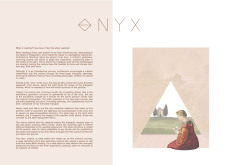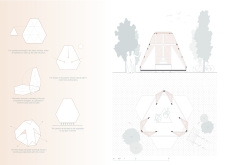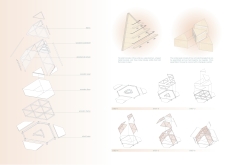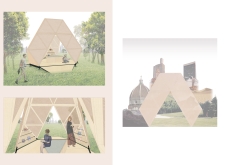5 key facts about this project
### ONYX Pavilion Overview
The ONYX Pavilion is situated within an innovative architectural context that merges the disciplines of literature and spatial experience. Drawing inspiration from the properties of the gemstone onyx, the design encourages introspection while maintaining a cohesive interaction with its environment. The pavilion adeptly serves its purpose as a space for reading and reflection, underlining the relationship between the built form and the outside world.
### Spatial and Structural Configuration
The architecture employs a distinct triangular geometry, utilizing equilateral triangles as the primary structural element. This choice not only creates a visual coherence that adapts to diverse surroundings but also establishes multiple triangular openings that foster transparency and continuity between the interior and exterior landscapes. The interior layout emphasizes a central triangular seating area paired with shelving, facilitating focused reading and contemplative engagement while allowing for flexible circulation throughout the space.
### Material Selection and Sustainability
The pavilion's material palette reflects principles of simplicity, functionality, and sustainability. Extensive use of wood in flooring, shelves, and structural components adds warmth and tactile richness to the environment. A steel base ensures structural integrity while elevating the pavilion to accommodate varying terrain. Additionally, the incorporation of fabric covering the triangular apertures softens the natural light entering the space, connecting the interior ambiance with the surrounding environment. This deliberate selection of materials enhances the pavilion’s adaptability while promoting a harmonious balance between built and natural elements.
### Interaction and Modularity
The design promotes user engagement through strategically defined zones for reading, relaxation, and social interaction, effectively transforming the pavilion into a communal space. Innovative structural features, such as modular seating created from extruded triangles, utilize magnet-based connections for ease of assembly, allowing for both versatility and functionality. The large triangular apertures ensure unobstructed views of the landscape, enhancing visual connectivity and fostering a profound psychological link between users and the natural setting.






















































